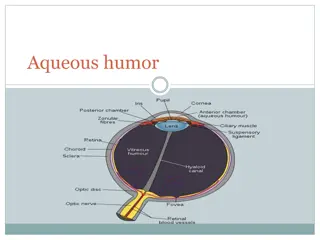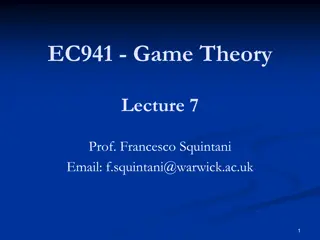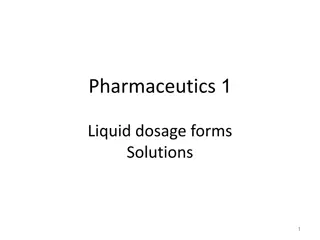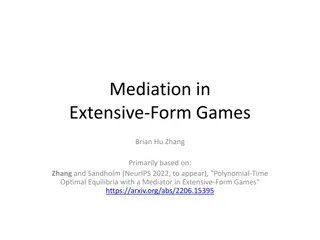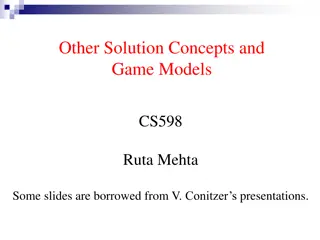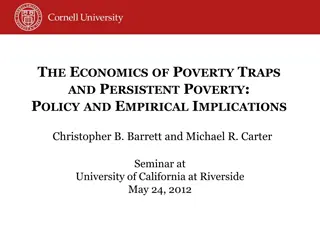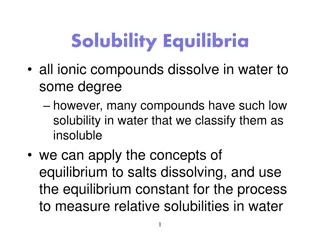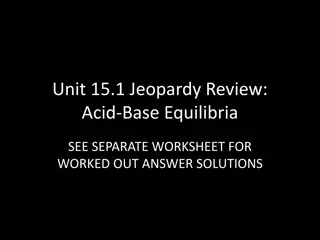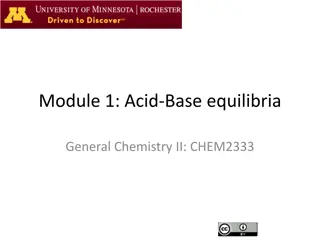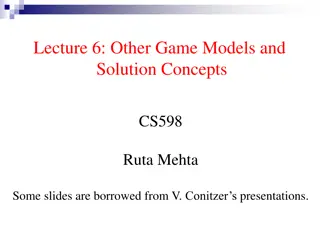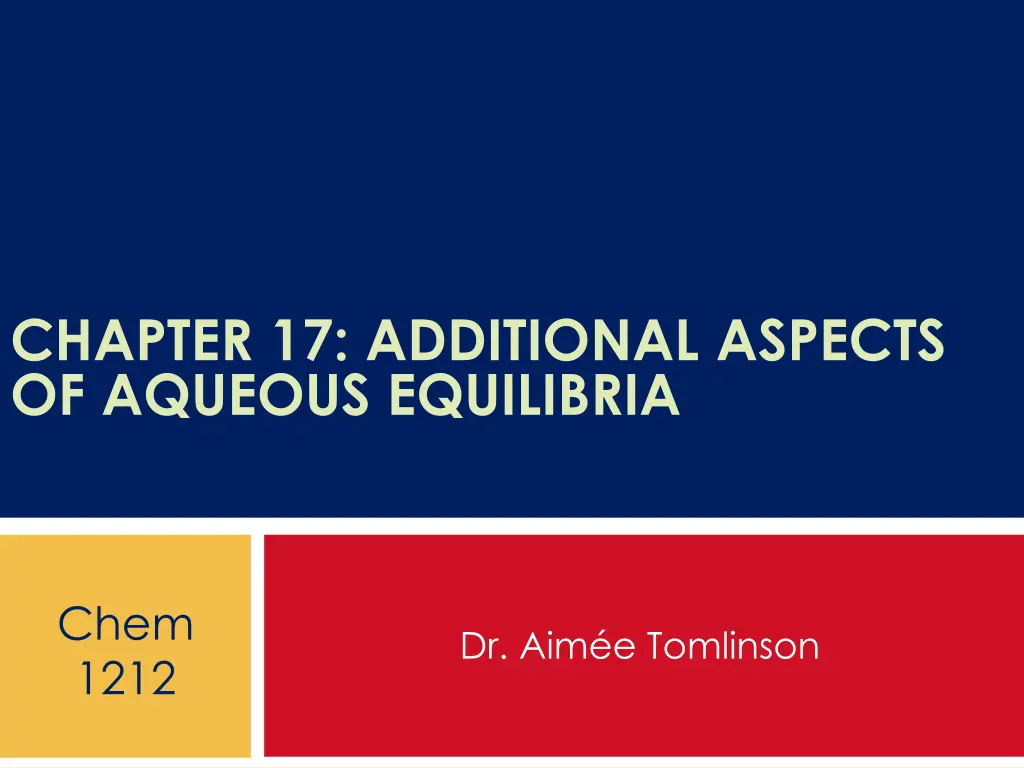
Additional Aspects of Aqueous Equilibria in Chemistry 1212 with Dr. Aime Tomlinson
Explore the common-ion effect and buffer solutions in Chapter 17 of aqueous equilibria. Learn how common ions impact equilibrium shifts and discover the role of buffer solutions in maintaining pH stability. Dive into examples and the Henderson-Hasselbalch equation to enhance your understanding of these crucial concepts in chemistry.
Download Presentation

Please find below an Image/Link to download the presentation.
The content on the website is provided AS IS for your information and personal use only. It may not be sold, licensed, or shared on other websites without obtaining consent from the author. If you encounter any issues during the download, it is possible that the publisher has removed the file from their server.
You are allowed to download the files provided on this website for personal or commercial use, subject to the condition that they are used lawfully. All files are the property of their respective owners.
The content on the website is provided AS IS for your information and personal use only. It may not be sold, licensed, or shared on other websites without obtaining consent from the author.
E N D
Presentation Transcript
CHAPTER 17: ADDITIONAL ASPECTS OF AQUEOUS EQUILIBRIA Chem 1212 Dr. Aim e Tomlinson
Section 17.1 Common-Ion Effect
Common Ions When two different species give rise to the same ion I.E. both NaCl & HCl give rise to Cl- Placing NaCl in HCl will repress the dissociation of the acid
Common-Ion Effect Defn: a shift based on equilibrium due to the addition of a common ion It is based on Le Ch telier s Principle Example: + + + H CO H O HCO H O 2 3( ) 2 ( ) l 3( ) 3 ( ) aq aq aq Adding HCO3- will shift the eq to the left As a consequence less H3O+ is produced The pH is higher than it would have been
Common-Ion Effect Example Calculate the pH of a solution prepared by mixing equal volumes of 0.20 M CH3NH2 and 0.60 M CH3NH3Cl (Kb = 3.7 x 10-4). What is the pH of 0.20 M CH3NH2 without addition of CH3NH3Cl?
Section 17.2 Buffer Solutions
pH Buffer A solution that resists changes in pH Generated from an acid with its conjugate base or a base with its conjugate acid pair Overall it is the result of the common-ion effect
Forming Good Buffers Need a large buffer capacity: the quantity of acid/base needed to significantly change the pH of a buffer Two ways to make a good buffer: Equal volumes where more concentrated solutions will give rise to a larger capacity Equal moles where larger volumes will give rise to larger capacities
Henderson-Hasselbalch Equation This is how we figure out how to make our buffers ?? + ?2? ? + ?3?+ ? ?3?+ ?? ??= ? ?3?+ ?? log??= log ? ?? log ?3?+ log??= log ? ?? ?? = ???+ log
Buffer Example I Calculate the pH and pOH of a 500.0 mL solution containing 0.225 M HPO4-2 and 0.225M PO4-3 at 25 C where Ka(HPO4-2)= 4.2 x 10-13.
Buffer Example II How would we prepare a pH = 4.44 buffer using CH3CO2H and CH3CO2Na (Ka = 1.8 x 10-5)?
Comprehensive Example This set of questions will include questions from both Chapter 16 & Chapter 17 Determine the pH for each of the following: a.) 0.100 M HC3H5O2 with Ka = 1.3 x 10-5 b.) 0.100 M NaC3H5O2 c.) Mixture of a.) and b.) d.) Mixture of c.) with 0.020 mol NaOH e.) Mixture of c.) with 0.020 mol HCl
Part a.) 0.100 M HC3H5O2 with Ka = 1.3 x 10-5
Part b.) 0.100 M NaC3H5O2 with Ka = 1.3 x 10-5
Part c.) 0.100 M HC3H5O2 & 0.100 M NaC3H5O2 with Ka = 1.3 x 10-5
Part d.) 0.100 M HC3H5O2 & 0.100 M NaC3H5O2 & 0.020 mol NaOH with Ka = 1.3 x 10-5
Part e.) 0.100 M HC3H5O2 & 0.100 M NaC3H5O2 & 0.020 mol HCl with Ka = 1.3 x 10-5
Comprehensive Example Putting it all together: Determine the pH for each of the following: a.) 0.100 M HC3H5O2 with Ka = 1.3 x 10-5 pH = 2.96 b.) 0.100 M NaC3H5O2 c.) Mixture of a.) and b.) d.) Mixture of c.) with 0.020 mol NaOH e.) Mixture of c.) with 0.020 mol HCl pH = 8.94 pH = 4.89 pH = 5.06 pH = 4.71 X 4
Sections 17.3 Acid-Base Titrations
Four Types of Neutralization Strong Acid + Strong Base Strong Acid + Weak Base + + + + + + NH HCl NH Cl HNO KOH H O K NO 3 4 3 2 3 + + + + + net ionic equation: NH H NH net ionic equation: H OH H O 3 4 2 Always lead to acidic solution Only anion of acid is a spectator ion Always lead to neutral solution Salt is present but as spectator ions Weak Acid + Strong Base Weak Acid + Weak Base + + + + + + NH HCN NH CN HCN KOH H O K CN 3 4 2 + + net ionic equation is same as above net ionic equation: HCN OH H O CN 2 Must compare Ka & Kb to determine pH There are no spectator ions Always lead to basic solution Only cation of base is a spectator ion
Titration Used to determine the concentration of an unknown
Titration Curve A plot of pH versus volume of titrant
Equivalence Point Point at which moles of acid = moles of base Strong acid with weak base: pH < 7.0 acidic Strong acid with strong base: pH = 7.0 neutral Weak acid with strong base: pH > 7.0 basic
pH Indicators Change color at the equivalence point Strong acid with weak base thymol blue Strong acid with strong base phenolphthalein Weak acid with strong base alizarin yellow
Titration Example I What is [NH3] if 22.35mL of 0.1145 M HCl were needed to titrate a 100.0mL sample?
Titration Example II Strong with Strong: A 15.0 mL sample of 0.200 M NaOH is titrated with 0. 250 M of HCl. Calculate the pH of the mixture after 10.0, and 20.0 mL of acid have been added.
Titration Example II Strong with Strong: A 15.0 mL sample of 0.200 M NaOH is titrated with 0. 250 M of HCl. Calculate the pH of the mixture after 10.0, and 20.0 mL of acid have been added.
Titration Example III Strong with Weak: A 25.0 mL sample of 0.100 M acetic acid (HC2H3O2) is titrated with 0.125 M of NaOH. Calculate the pH of the mixture after 0.0,10.0, 20.0, and 30.0 mL of base have been added. (Ka = 1.8 x 10-5)
Titration Example III Strong with Weak: A 25.0 mL sample of 0.100 M acetic acid (HC2H3O2) is titrated with 0.125 M of NaOH. Calculate the pH of the mixture after 0.0,10.0, 20.0, and 30.0 mL of base have been added. (Ka = 1.8 x 10-5)
Titration Example III Strong with Weak: A 25.0 mL sample of 0.100 M acetic acid (HC2H3O2) is titrated with 0.125 M of NaOH. Calculate the pH of the mixture after 0.0,10.0, 20.0, and 30.0 mL of base have been added. (Ka = 1.8 x 10-5)
Titration Example III Strong with Weak: A 25.0 mL sample of 0.100 M acetic acid (HC2H3O2) is titrated with 0.125 M of NaOH. Calculate the pH of the mixture after 0.0,10.0, 20.0, and 30.0 mL of base have been added. (Ka = 1.8 x 10-5) X 2
Section 17.4 Solubility Equilibria
Solubility Product It is the equilibrium constant for solids in solution, Ksp + = m x [ ] [ ] M X mM xX K M X ( ) ( ) m x aq aq sp An actual example looks like: + + = 3.9 10 2 ( F 11 2 CaF Ca F K 2( ) = ) ( ) s aq aq sp + 2 ( 2 [ ][ ] K Ca ) ( ) sp aq aq
Solubility Example Determine the equilibrium concentrations (and solubilities) of BaF2(s), Ksp = 1.7x10-6. X 2
Section 17.5 Factors that Affect Solubility
Three Solubility Factors Common-Ion Effect pH Complex ion formation we are skipping this one
Common-Ion Solubility Example Calculate the solubility of calcite (CaCO3) in 0.00100 M of Na2CO3 and in just plain water (Ksp = 4.5x10-9 at 25 C).
pH Solubility Example If the salt added possesses a conjugate acid or conjugate base then pH will impact the solubility of the salt + + 2 ( 2 3( CaCO Ca CO 3( ) CO + ) HCO ) s aq aq + 2 3( H ( ) ) 3( ) aq aq aq + + + + 2 ( CaCO H Ca HCO 3( ) ( ) ) 3( ) s aq aq aq Addition of acid will pull carbonate out of the solution Recall LCP when we remove product the eq will push forward This leads to more CaCO3 being dissolved Overall this trend demonstrates why so many compounds are more soluble in acidic solutions X 2
Sections 17.6-17.7 SKIP!


